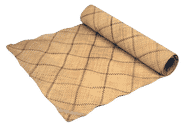Presented by Museum of the Peace Corps Experience and American University Museum
c. 1967
Weno, Chuuk Lagoon, Micronesia
Pandanus fiber, 76 1/2 x 36 1/2 in.
Collection, Museum of the Peace Corps Experience
Gift of Richard Sundt, Micronesia, Rongelap Atoll 1967–69

In much of the world people take their furniture for granted. In the Pacific Islands, people take for granted the unnecessity of furniture. I discovered this when I met my first challenge as a Peace Corps trainee on Udot Island in the Chuuk Lagoon.
We lived in a spare little western-style cabin. A utilitarian mat covered the floor. There were no beds. I was unprepared for sleeping on the floor, especially on that rough mat. When I learned that the local Udotese slept on well-crafted mats fashioned from plaited leaves of the native pandanas tree, I found just the right one in a local shop so I could sleep like a native.
After three months of training, I boarded a field ship in Majuro that would take me 400 miles northwest to Rongelap Atoll. In 1954 the US Navy evacuated residents of Rongelap after fallout from a hydrogen bomb test on nearby Bikini Atoll contaminated the islands; three years later, some of them began to return home. In 1967 the atoll’s main and only inhabited island had a population of about 120 residents who lived on three square miles of land. My assignment was to start a coconut rehabilitation project.
I began adjusting to living—and sleeping—in my new home. One day a woman from the neighborhood came to my door with a gift. She had made me a pillowcase embroidered with flowers and leaves. An inscription, written with a marker, said, “Ememlok ijen ko aö, ilo ien ne ij babu”—“My place is better with this pillow when I go down to sleep.” Indeed, it was!
Several months later the owners of the house next door returned to Rongelap. As a gesture of friendship, the husband offered me a foam rubber mattress that he had brought home. He said it would help me sleep like a ribelle—a foreigner. I immediately placed it under my mat. Who needed a bed?
In 1985 the people of Rongelap had to evacuate again. The land remained too irradiated for human habitation, a determination that came too late for the many islanders who suffered radiation illnesses. If human-generated disasters have made life difficult for residents of these low-lying atolls, the Marshallese long ago learned to adapt and harness their limited resources to fashion a sustainable and self-sufficient way of life—something I learned from them, something we all aspire to achieve.
The Committee for a Museum of the Peace Corps Experience is a 501(c)(3) private nonprofit organization. Tax ID: EIN # 93-1289853
The Museum is not affiliated with the U.S. Peace Corps and not acting on behalf of the U.S. Peace Corps.
Museum of the Peace Corps Experience © 2024. All Rights Reserved.